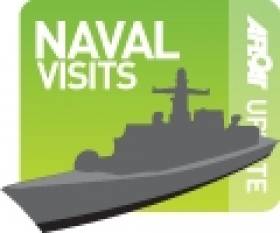Displaying items by tag: Legenderry Maritime Festival
#NavalLegenderry - As well as the flotilla of the 12-strong Clipper Round the World Race yachts at the Legenderry Maritime Festival, the north-west city has welcomed a pair of tallships and a naval visitor on Lough Foyle.
The Naval Service's OPV80 class vessel which entered service in 1999, was made open to the public today while berthed at the city along McFarland Quay.
This day last week the offshore patrol vessel was off the south coast where she was expected to take part in a major annual naval exercise as previously reported, though she could not due to operational reasons.
This left newbuild L.E. Samuell Beckett and veteran L.E. Aoife to continue exercises involving Drug Interdiction Teams engaged in boarding practice and an Air Corps helicopter performing winching operations with the vessels off the coast of Cork Harbour.
The visit of L.E. Roisin on the Foyle consolidates relationships between these islands, noting she along with her sister L.E. Niamh were built at the UK shipyard of Appledore Shipbuilders Ltd in north Devon.
The yard near Bideford on the River Torridge is today part of Babcock Group's marine division where newbuild OPV90 L.E. James Joyce is under construction and where a third option of 'Beckett' class based on the 'Roisin' class was announced in recent weeks.
#LegenderryTallShips – The Legenderry Maritime Festival held in the north-west city is where Lough Foyle has welcomed the return of the Clipper Round the World Yacht Race 2014 but also some visiting tall-ships which too are open to the public.
So why not come along and board the tallships, Earl of Pembroke and Phoenix which together have appeared in many films and TV drama's and are berthed alongside McFarland Quay. From that quayside you can embark on board these wonderful sailing vessels which are open only today, (Thursday up to 6pm). For more details of festival programme visit here.
Since the festival began on mid-summers day and concludes on Sunday 29 June, the city and along Foyle Quay has been host for the homecoming festival in welcoming the 12 strong fleet of Clipper 70 yachts. Notably as previously reported, the Derry-Londonderry-Doire skippered by the city's hero, Sean McCarter following victory in race 14 from New York to the yacht's homeport as part of the world's longest ocean race.
There will also opportunities to visit these impressive racing boats as according to the festival organiser website click HERE, Clipper Ventures are making available two of the race yachts for tours today between (2-7pm), tomorrow Friday, June 27 (2-7pm) and also on Saturday, June 28 (9am-1pm).
Forming the focalpoint of the festival is at Foyle Quay where the summer promenade, complete with race village, marine marquees, award winning continental markets and a host of sea faring activities on and off shore will be held for all to enjoy.
So to soak up the action be it learning to canoe or sail a dingy or if you're happy to just go with the flow of the festival there's something to suit everyone. Come on, dive in and blow your inhibitions out of the water!
Last but not least will be the festival's farewell send-off in bidding bon voyage to the Clipper yachts as the Parade of Sail departs on Sunday (12 noon) from MacFarland Quay for the race start at Greencastle in Co Donegal.
The Red Arrows will perform their trademark formations with close-passes and dynamic loops and rolls at the mouth of the River Foyle between Greencastle in Co. Donegal and Magilligan/Binevenagh in Co. Derry.
For more information on the full programme of events or details on how to get involved, visit www.legenderrymaritimefestival.com






























































